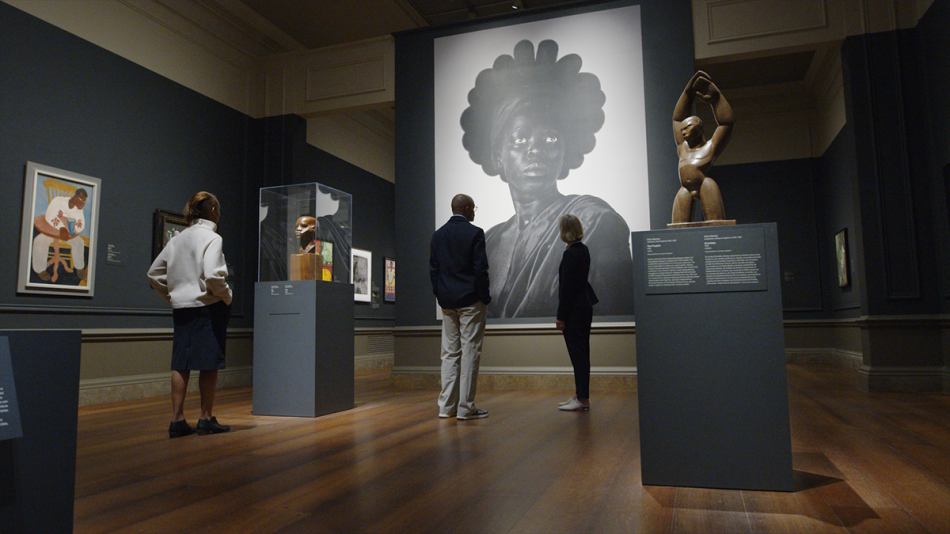Into Bondage
1936
Aaron Douglas
Painter, American, 1899 - 1979

We glimpse the harrowing drama unfolding in this painting, as if we are crouching by the roots of the tropical foliage and peering through a space between the leaves. Our focus is on the anonymous silhouettes of men and women, their shackles more prominent than their features. They slouch toward waiting ships. We know the tragic outcome of their impending journey: enslavement in a distant country. A pulsating light on the horizon—a star—casts a bright beam on the large figure at center. Aaron Douglas, an artist of the Harlem Renaissance, acknowledges his ancestors’ resilience and hope in the face of oppression.
Artwork overview
-
Medium
oil on canvas
-
Credit Line
-
Dimensions
overall: 153.4 × 153.7 cm (60 3/8 × 60 1/2 in.)
framed: 165.1 × 164.47 × 8.26 cm (65 × 64 3/4 × 3 1/4 in.) -
Accession Number
2014.79.17
More About this Artwork

Article: Look to the Light: A Reflection on Aaron Douglas’s “Into Bondage”
On Juneteenth, Aaron Douglas’s “Into Bondage” prompts reflections on the way forward through oppression and anguish.

Video: Is Pablo Picasso Overrated?
The National Gallery’s own Harry Cooper and LaStarsha McGarity declare Picasso overrated and question if Chet Hanks is indeed the greatest artist of all time on our fifth episode of Ask the National Gallery Anything.

Video: Two-Minute Tour: Afro-Atlantic Histories
Join exhibition curators Kanitra Fletcher, Steven Nelson, and Molly Donovan on a two-minute tour of the 2022 exhibition Afro-Atlantic Histories.
Artwork history & notes
Provenance
Commissioned 1936 for the Hall of Negro Life, Texas Centennial Exposition, Dallas;[1] possibly Wiley College, Marshall, Texas.[2] Joseph Mack [1920-1986]; sold to Thurlow Evans Tibbs, Jr. [1952-1997], Washington, by 1987;[3] by gift and partial purchase 1996 to the Corcoran Gallery of Art, Washington; acquired 2014 by the National Gallery of Art.
[1] A letter from Jesse O. Thomas and Alonzo J. Aden (General Manager and Curator of Exhibitions, respectively, of the Hall of Negro Life) to Aaron Douglas, dated 5 July 1936, hints that the Harmon Foundation gave financial support for the commission; copy in NGA curatorial files, and the Evans-Tibbs Collection, Vertical Files, NGA Library.
[2] According to Hilda Stewart Proctor, “The Aaron Douglasses Celebrate 25th Year,” clipping from an unidentified newspaper, about 18 August 1951; copy in NGA curatorial files, and the Evans-Tibbs Collection, Vertical Files, NGA Library.
[3] In a Condition and Treatment Report for the painting, prepared by Quentin Rankin (3 April 1987, Corcoran conservation records, in NGA Painting Conservation Department), Thurlow Evans Tibbs Jr. is specified as the owner.
Associated Names
Exhibition History
1936
Texas Centennial Exposition, Lobby of the Hall of Negro Life, Dallas, 6 June - 29 November 1936, no catalogue.
1989
Black Art, Ancestral Legacy: The African Impulse in African-American Art, Dallas Museum of Art; High Museum of Art, Atlanta; Milwaukee Art Museum; Virginia Museum of Fine Arts, Richmond, 3 December 1989 - 24 March 1991, unnumbered checklist.
1997
Rhapsodies in Black: Art of the Harlem Renaissance, Hayward Gallery, London; Arnolfini, Bristol; Mead Gallery, University of Warwick, Coventry; M.H. de Young Memorial Museum, San Francisco; Corcoran Gallery of Art, Washington; Los Angeles County Museum of Art; Museum of Fine Arts, Houston, 19 June 1997 - 14 February 1999, no. 19.
1999
Celebrating the Legacy: African American Art from the Collection, Corcoran Gallery of Art, Washington, 30 July - 22 September 1999, no catalogue.
2002
Celebrating the Legacy: African American Art from the Collection, Corcoran Gallery of Art, Washington, 10 January - 25 February 2002, no catalogue.
2004
Figuratively Speaking: The Human Form in American Art, 1770-1950, Corcoran Gallery of Art, Washington, 20 November 2004 - 7 August 2005, unpublished checklist.
2005
Encouraging American Genius: Master Paintings from the Corcoran Gallery of Art, Corcoran Gallery of Art, Washington; Museum of Fine Arts, Houston; Parrish Art Museum, Southampton; Mint Museum of Art, Charlotte; John and Mable Ringling Museum of Art, Sarasota, 27 August 2005 - 29 April 2007, checklist no. 91.
2007
Aaron Douglas: African American Modernist, Spencer Museum of Art, University of Kansas, Lawrence; Frist Center for the Visual Arts, Nashville; Smithsonian American Art Museum, Washington; Schomburg Center for Research in Black Culture, New York, 8 September 2007 - 30 November 2008, unnumbered catalogue.
2009
American Paintings from the Collection, Corcoran Gallery of Art, Washington, 6 June - 18 October 2009, unpublished checklist.
2013
American Journeys: Visions of Place, Corcoran Gallery of Art, Washington, 21 September 2013 - 28 September 2014, unpublished checklist.
2016
The Color Line: African-American Artists and Segregation, Musée du Quai Branly, Paris, 2016-2017, unnumbered catalogue, repro.
2018
Historias Afro-Atlanticas, Museu de Arte de São Paulo Assis Chateaubriand, São Paulo, 2018, no. 57, repro.
2020
Vida Americana: Mexican Muralists Remake American Art, 1925-1945, Whitney Museum of American Art, New York, 2020 - 2021, unnumbered catalogue, fig. 16.
2022
Afro-Atlantic Histories, The Museum of Fine Arts, Houston, Houston; National Gallery of Art, Washington; Los Angeles County Museum of Art, Los Angeles; The Museum of Fine Arts, Houston, Houston; Dallas Museum of Art, Dallas, 2022 - 2024, fig.8.
Bibliography
n.d.
Letters, Jessie O. Thomas and Alonzo J. Aden, Office of the United States Commissioner General, Texas Centennial Exposition to Aaron Douglas, 5 July 1936; Evans-Tibbs Archives, formerly Corcoran Gallery of Art Archives, now NGA Library, Washington.
1936
J. B. "Negro Art Works Being Displayed at Fair Exhibit [exh.review]." Dallas Morning News (28 June 1936): 2:4.
Tedford, Claude C. "Art Section Most Beautiful Part of Negro Building at Texas Centennial Exhibition [exh. review]." Associated Press (10 September 1936).
1938
Thomas, Jesse O. Negro Participation in the Texas Centennial Exposition. Boston, 1938: 25, 26, 27, 102, 129.
1971
Bontemps, Jacqueline. "The Life and Works of Aaron Douglas: A Teaching Aid for the Study of Black Art." M.A. Thesis, Fisk University, Nashville, 1971.
1989
Powell, Richard J. "From Renaissance to Realization, 1920-1950." In African American Artists, 1880-1987: Selections from the Evans-Tibbs Collection. Guy C. McElroy et al., eds. Exh. cat. Smithsonian Institution Traveling Exhibition Service, Washington, D.C., 1989: 71 n. 3.
1990
Terry, Clifford. "African Impulse Milwaulkee Exhibit Reveals the Strong Legacy of Black Art [exh. review]." Chicago Tribune (28 October 1990): 16.
1991
Robinson, Jontyle Theresa. "Recent Exhibitions: Black Art: Ancestral Legacy [exh. review]." African Arts 24, no.1 (January 1991): 78-79.
1996
Lewis, Jo Ann. "A Fresh Coat of Paintings; Washington Collector Gives the Corcoran a New Focus [exh. review]." The Washington Post (14 September 1996): C:1.
Corcoran Day and Night 3, no.4 (July/August 1996): cover, repro., 2, repro., 5.
Shaw-Eagle, Joanna. "Major Gift for the Corcoran." The Washington Times (10 May 1996): C:13.
Lewis, Jo Ann. "Corcoran to be given African American Art." The Washington Post (8 May 1996): A:16.
1997
Murph, John. "The Evans-Tibbs Collection: Prints, Drawings and Photographs by African American Artists [exh.review]." New Art Examiner 24 (February 1997): 51.
Hendrickson, Paul. "The Legacy; Art Collector Thurlow Evans Tibbs Left Behind an Unforgettable Gift. And Some Unsettling Questions." The Washington Post (20 April 1997): G:7.
1998
Baker, Kenneth. "Black Renaissance; Legion of Honor Show Surveys Harlem's Artistic Zenith [exh. review]." San Francisco Chronicle (16 January 1998): D:1, repro.
Bonetti, David. "Black Studies: Harlem Renaissance at Legion of Honor [exh.review]." San Francisco Chronicle (1 February 1998): M:18, repro.
Powell, Richard J. "Art of the Harlem Renaissance." American Art Review 10, no. 2 (March-April 1998): 133, repro.
Iverem, Esther. "The Body Eclectic New Way of Seeing Things." The Washington Post (11 April 1998): B:1, repro.
Walsh, Daniella. "Riches of the Harlem Renaissance; LACMA Takes a Wide-Lens View of a Uniquely American Cultural Phenomenon [exh. review]." Orange County Register (23 August 1998): F:28.
1999
Heyd, Milly. Mutual Reflections: Jews and Blacks in American Art. Brunswick, New Jersey, 1999: 38, 39, repro.
2000
Smith, Rochelle, and Sharon L. Jones, eds. The Prentice Hall Anthology of African American Literature. Upper Saddle River, New Jersey, 2000: after 86, repro.
Holt, Thomas C., and Elsa Barkley Brown, eds. Major Problems in African-American History. 2 vols. Boston, 2000: 1:cover, repro.
2001
Rochelle, Belinda. Words with Wings: A Treasury of African-American Poetry and Art. New York, 2001.
McNatt, Glenn. "The Works of Black Artists, Rooted in the Harlem Renaissance, Can be Seen in Local Galleries This Month [exh.review]." Baltimore Sun (25 December 2001): 1,F.
2002
Lewis, Jo Ann. "Painter Aaron Douglas, A Re-Renaissance Man; The Artist Gets His Due, Times Two, at Arena and the Corcoran." The Washington Post (13 January 2002): C4.
Badder, Susan. "Into Bondage." In A Capital Collection: Masterworks from the Corcoran Gallery of Art. Edited by Eleanor Heartney. London, 2002: 172, 200, repro., 201.
2005
Burgard, Timothy Anglin. "Aaron Douglas, Aspiration." In Masterworks of American Painting at the De Young. Edited by Timothy Anglin Burgard. San Francisco, 2005: 342, 344, repro.
2006
Maschal, Richard. "Strokes of Genius [exh. review]." The Charlotte Observer (1 October 2006): E:3, repro.
Shinn, Susan. "Viewing Masters: 'Encountering American Genius: Master Paintings from the Corcoran Gallery of Art' Opens at the Mint [exh. review]." Salisbury Post (12 October 2006): D:7.
2007
Bennett, Lennie. "The Coming of Age of American Art [exh. review]." St. Petersburg Times (18 February 2007): 8L, repro., 9L.
Emery, Mary Lou. Modernism, The Visual, and Caribbean Literature. Cambridge, England, 2007: 82, repro.
2008
Gopnik, Blake. "Points of Departure [exh. review]." The Washington Post (1 June 2008): M:7, Living and Arts, repro.
May, Stephen. "Renaissance of a Modernist." ARTnews 107, no. 9 (October 2008): 146-149, 147, repro.
Bernier, Celeste-Marie. African American Visual Arts. Edinburgh, 2008: 82, repro.
2009
Sadlier, Rosemary, et al. Black History: Africa, the Caribbean, and the Americas. Toronto, 2009: 178, repro., 363.
2010
Barson, Tanya. "Introduction: Modernism and the Black Atlantic." In Afro Modern: Journeys Through the Black Atlantic. Edited by Tanya Barson and Peter Gorschluter. Exh. cat. Tate Liverpool, 2010: 11, repro.
2011
Wingate, Jennifer. "Aaron Douglas, Into Bondage." In Corcoran Gallery of Art: American Paintings to 1945. Edited by Sarah Cash. Washington, 2011: 37, 246-247, 282, repro.
Jordan, Glenn. "Re-Membering the African-American Past: Langston Hughes, Aaron Douglas and Black Art of the Harlem Renaissance." Cultural Studies: Theorizing Politics, Politicizing Theory 25, no. 6 (November 2011): 873, 874, 875, repro., 884.
Greenhalgh, Paul. Fair World: A History of World's Fairs and Expositions From London to Shanghai 1851-2010. Berkshire, 2011: 142, repro., 143.
2012
Welky, David, ed. American Between the Wars: 1919-1941: a documentary reader. Malden, Massachusetts, 2012: 52, 54, repro.
Parsons, Jim and David Bush. Fair Park Deco: Art and Architecture of the Texas Centennial Exposition. Fort Worth, 2012: 145, repro.
Inscriptions
lower right: AARON DOUGLAS
Wikidata ID
Q20193037



